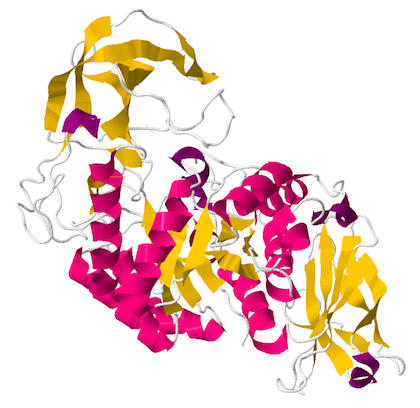α-amylase (Amylex)

Amylex® is a liquid enzyme preparation containing an outstandingly heat-stable α-amylase.
SOURCE
Amylex® is a heat-stable α-amylase produced by a genetically-modified strain of Bacillus licheniformis.
COMMERCIAL USES
Alpha-amylase is used in the following industries:
Starch
In the starch industry amylase is used for the continuous liquefaction of starch at temperatures of up to 105–110 °C, taking advantage of the extreme heat stability of this enzyme.
Brewing
Brewers also use Amylex to liquefy starch added to wort used in brewing.
Sugar
In the sugar industry, amylase is used to break down the starch present in sugar cane juice. Thereby the starch content of raw sugar is reduced and filtration at the refinery is facilitated.
Textiles
In the textile industry, amylase is used for high-speed, high-temperature desizing of textiles before dyeing.
EDUCATIONAL USES
This enzyme can be used instead of salivary amylase in simple investigations of starch breakdown (using iodine/potassium iodide solution to test for the disappearence of the starch). Bear in mind three things however:
1. Make up the soluble starch solution correctly
For example, to make up a 1% (w/v) starch solution:
- Weigh out 10 g of starch powder into a 250 mL beaker.
- Add 20–30 mL of cold distilled water and mix into a thick paste.
- Boil 500 mL of distilled water in a 1 litre beaker.
- Add the starch mixture to the boiling water and continue boiling for a few minutes (we use a microwave oven to do this, to ensure that the starch does not burn).
- Make up to the final volume accurately with cold distilled water.
- Allow to cool.
2. Dilute the enzyme appropriately
You may need to dilute the enzyme to ensure that the reaction takes place slowly enough for students to monitor it. Using a 0.1% (v/v) dilution of Amylex and 1% starch will give reasonable results at room temperature.
3. Amylex is heat stable
You can easily show the effect of temperature on the activity of the enzyme and obtain a good straight line graph, but because Amylex is heat stable (its optimum activity is at about 80 °C) it is not the right enzyme to use if you wish to mislead students into thinking that all enzymes are denatured at about 50 °C.
Please note that this enzyme preparation contains reducing sugars, and even when diluted 100-fold it will give a positive result with Benedict’s reagent.
ACTIVITY
The enzyme is an endoamylase which hydrolyses α-1,4 glycosidic linkages in amylose and amylopectin, the two components of starch. Starch is therefore broken down rapidly to soluble dextrins and oligosaccharides. Amylex exhibits optimum activity at about pH 6 and 90 °C. Please refer to the data sheet provided with the enzyme for further details. Note: Animal α-amylases (but NOT microbial ones such as Amylex) require chloride ions to activate them.
STORAGE
Amylex should be stored at 3–5 °C, and will at that temperature maintain the declared activity for at least a year. However, even when stored at 25 °C, the enzyme preparation will retain its declared activity for at least 3 months. Do not freeze.
SAFETY

DANGER. May cause allergy or asthma symptoms or breathing difficulties if inhaled. See Safety Data Sheet for further advice.
SAFETY DATA SHEET
ORDERING
All of the prices on this page are in GBP and do not include Value Added Tax (VAT). This tax applies within the European Union only. Postage and handling must also be paid on orders from outside the United Kingdom. Details of how to order are given on the price list and on the Ordering web page.
Please note: We are unable to supply this product to addresses in the United States of America.
PLEASE NOTE
THE NCBE SUPPLIES THESE ENZYMES TO SCHOOLS AND COLLEGES FOR EDUCATIONAL USE ONLY. COMMERCIAL USERS OF ENZYMES OR THOSE WHO REQUIRE ENZYMES FOR RESEARCH PURPOSES SHOULD CONTACT THE ENZYME MANUFACTURERS OR OTHER SUPPLIERS, NOT THE NCBE.

